Following my last post on the Soy and Chocolate tasting, some of you dear readers might be wondering, how did Michael Recchiuti get the idea to pair soy with chocolate? The answer is Hodo Soy Beanery, an artisan soy company in Oakland founded by Minh Tsai. At the Hodo Soy Beanery, soybeans are turned into soymilk, tofu, and yuba, and an array of prepared foods. I was lucky enough to be invited on a tour of the factory and learn more about the noble soybean – even as a veteran tofu eater, there was a lot for me to learn!
A shot of the factory interior. Hodo Soy carefully selects the soybeans it uses for ideal protein and fat content; the soybeans all come from a Midwest cooperative and are organic and non-GMO. To the right side of the photo are the tanks where the soybeans are cooked, ground into a mash, and then separated into soymilk and leftover pulp called okara. The okara doesn’t go to waste – Hodo Soy typically sends it to farms to be used for feeding animals, but it can be used in the kitchen, as the okara financier at Michael Recchiuti’s Soy and Chocolate Tasting proved. However, Hodo Soy typically doesn’t sell its okara.
It does sell the soymilk though, and it’s delectable stuff. Growing up in a Chinese household, I was exposed to soymilk at an early age – those little rectangular Vitasoy boxes were omnipresent in the pantry. I also loved the hot, fresh soymilk served with golden fritters, the Chinese version of weekend brunch. I relished the creamy, slightly beany taste of the soy milk, so I’ve never had the hang ups some people have about drinking “bean juice.”
Soymilk is meant to taste like soymilk, not like dairy milk, which perhaps is why those who are looking for something that tastes like milk but-isn’t-milk might come away disappointed. And I wonder if some of the Westernized brands of soy milk are trying to cover up the beany flavor, which results in this (to me at least) strange, chemical taste and chalky mouthfeel. The first time I drank some non-Vitasoy, “vanilla-flavored” soy milk I said, “Oh! No wonder people say they don’t like soymilk!” Soymilk isn’t meant to taste like milk, it’s not meant to taste to like some bland-but-healthful drink, it’s meant to taste like soymilk.
Minh and Hodo Soy clearly embrace this philosophy – their soymilk contains nothing but soybeans, water, and some sugar for the sweetened version. No chemicals or preservatives – you have to consume it quickly, but in my opinion it’s not that hard. I took a bottle of Hodo Soy’s soymilk home with me; it’s been a while since I’ve guzzled milk out of the jug, but that’s what I wanted to do with this soymilk!
Pictured above, some of Hodo Soy’s medium tofu on the left, and their braised tofu on the right. (For an explanation of how tofu is made, see the Soy and Chocolate recap for a quick demo by Minh.) Tofu is typically sold in soft/silken, medium, and firm textures, but as Minh noted, “Here in America they really like their tofu firm – there is even extra-firm sold in stores!” While firmer tofu is good for cooking, soft or silken tofu is where the true art of tofu-making emerges. The difference in tofu texture is based on the amount of water contained in the tofu: for firm tofu, most of the water has been pressed out so the result is compressed, tight block. Silken tofu contains as much water possible while the curd just maintains integrity; typically the tofu is not even pressed, as that would make the curds firm up, but instead the mixture is allowed to just set. While soft and silken are often used interchangeably, true silken tofu is like a barely set flan – it just holds its shape, and if you agitate it too much it will fall apart. You spoon it up like a cream-white custard, and it virtually dissolves in your mouth.
Hodo Soy’s silken tofu comes in little tubs packed completely full so the tofu has less chance of wobbling around and falling apart during transport. If you’ve only ever seen the vacuum-sealed packs of firm tofu slabs in the supermarket, you might even think this is nascent tofu, and in a way it is: it’s delicate and perfect and a promise, like a unbroken eggshell. I take a spoonful and I think, how could anyone ever call tofu just health food? It’s comfort food.
This is the most eye-catching part of Hodo Soy’s operation: the specially-designed tables where they create yuba, or tofu skin. Similar to what happens when milk is heated, when soy milk is heated, a skin forms on the surface. This skin is then carefully pulled off and allowed to dry. You can see the tables are set up to allow maximum surface area for the yuba to form. One of the workers then hand-peels off each piece of yuba and hangs it up – almost looks like a laundry line, doesn’t it? Yuba is highly prized in Asia for its high protein content and flavor. As you can imagine, “harvesting” the yuba by hand is a time consuming process, and machines have been created to mechanize the process, but Minh believes it compromises the quality of the result. Thus at Hodo Soy they do it the old school way – it’s a beautiful, evocative experience to see the steam rising from the trays of soymilk and the sheets of yuba slowly swaying in the steam.
Because yuba contains so much protein, it is an ideal meat substitute – if you ever go to a Chinese restaurant and see items like “Vegetarian Goose” on the menu, likely they are made with yuba. Lightly pan fried in soy sauce, these yuba strips are like slightly chewy noodles; Hodo Soy does recommend eating them that way, or using them as spring roll wrappers.
Boxes of Hodo Soy’s prepared items all lined up. You can also see the bottles of soymilk in the back. All of Hodo Soy’s items have a very limited shelf life as there are no preservatives used. Not only does this speak to the integrity of their operation, but I think it really reinforces the concept of tofu as an artisanal product, made in small batches with care. Minh explained how when he was a young boy in Vietnam, he would walk with his grandfather to the market every day and buy a block of freshly made tofu from local tofu maker. It would be consumed that night for dinner -the very definition of fresh. When MInh came to the US, the processed packages in the supermarket had no resemblance to the tofu in his memory. So he set out to create his own tofu. That quest led to Hodo Soy tofu being sold at farmers’ markets, high end grocery stores, and finally the opening of the Hodo Soy factory in Oakland.
I applaud MInh and Hodo Soy for revitalizing the art of tofumaking in the West – I asked him if he was intimidated by tofu’s less-than-sexy reputation here when he first starting selling his product, and he admitted yes, but he was pleasantly surprised to find an quickly growing audience for his tofu at farmers’ markets, and not all of them Asian! Now that Hodo Soy has a brand new factory, their products are also carried at select stores around the Bay Area. Unfortunately, because of the perishability and fragility of their product, Hodo Soy does not ship outside of the area. Perhaps they will expand in the future, but for now, if you’re looking to expand your soy experience, try going to your local Asian markets. Some of them may sell fresh tofu or soymilk. Also, look for Chinese(especially Taiwanese) restaurants that open in the morning – they will often serve hot bowls of fresh soymilk – delicious, especially with Chinese-style fried doughnuts.
One of my very favorite tofu dishes is, unsurprisingly, a dessert: called dou hua, or tofu flower, it is a sort of pudding made with silken tofu. Because silken tofu is so fragile, it is often drizzled with sauce or covered with toppings, and then spooned up like an ice cream sundae. There are savory versions of dou hua, but the Cantonese version I loved getting in dim sum houses features a scoop of silken tofu in a sweet ginger syrup. As you dip your spoon in, the tofu fragments into little pieces that you slurp up with the syrup like a sweet soup. Tofu and ginger – perhaps not the first ingredients you’d think of for dessert, but dou hua is both refreshing and comforting at the same time.
Hodo Soy generously sent me home with a tub of their silken tofu, and I thought about making this dessert, but as they actually sell their own version of dou hua, I decided to get creative and make a dou hua inspired dessert – a ginger tofu pudding. Hodo Soy’s silken tofu is perfect for this since it’s so delicate – it is almost like a custard. If you can’t find super soft, silken tofu, a soft tofu will work as well – I tested this with a supermarket brand and it came out fine, just slightly denser in texture. With some late fall peaches on top, I found this a tasty cross of East and West. Hope you enjoyed learning about the fascinating soybean!
Disclosure: I received several of Hodo Soy’s products for review.
Ginger Tofu Pudding
1 1/2 cups water
1 cup sugar
2 inches ginger root, cut into 1/8″ slices
11 ounces silken tofu
3 grams powdered gelatin
Combine the water and sugar in a medium saucepan. Boil over medium heat until sugar dissolves.
Add in ginger and continue boiling for about 10 minutes. The syrup should thicken slightly.
Remove from heat and take out pieces of ginger.
Place tofu in a food processor and process until smooth.
Pour in ginger syrup and process to combine.
Place gelatin in a heatproof bowl and stir in 1/4 cup of water. Let sit for a couple minutes to let it combine.
Place gelatin in microwave and heat for 20 second intervals until the gelatin has fully dissolved into the water. Do not let it boil.
Strain the tofu mixture into a bowl. Pour in the gelatin and stir to combine.
Divide the mixture among individual cups or bowls. Place in refrigerator and let chill overnight to set.
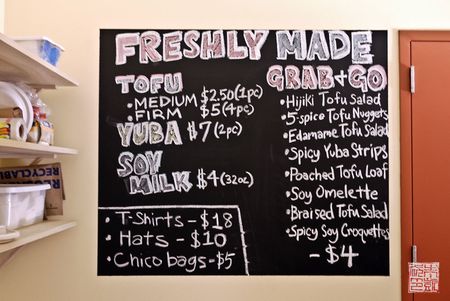
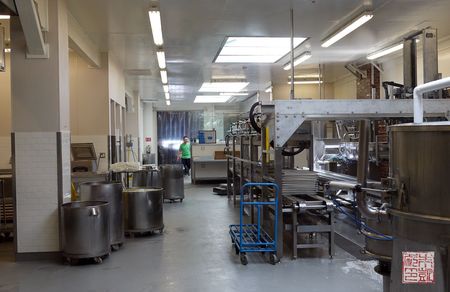
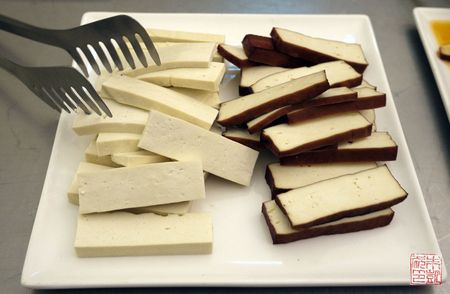


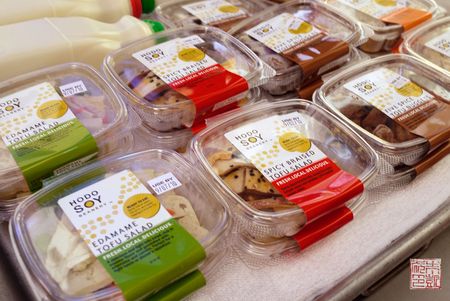
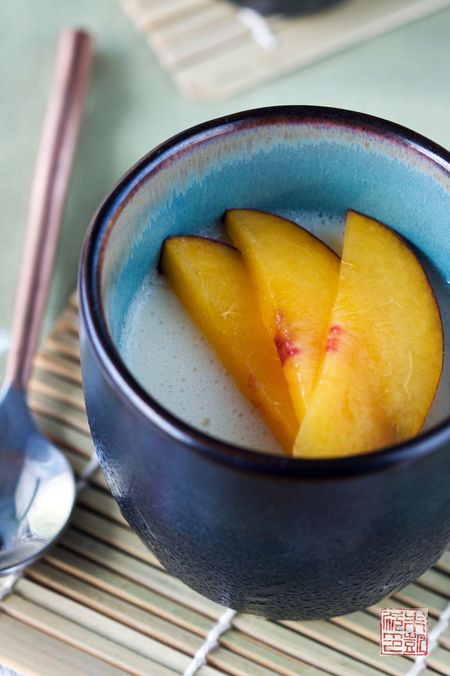
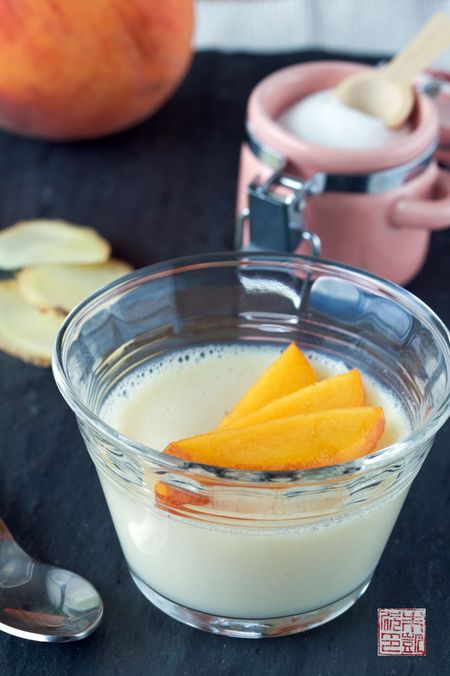


Mm I love tofu in all its forms XD. I love ginger tofu pudding, so soft and delicious! I’ve seen versions that rely solely on ginger juice to coagulate the soymilk.
I’ve seen them at several farmer’s market, but I haven’t tried any of their products.
The ginger-tofu pudding sound fabulous.
i love tofu. it’s very comforting for me. this reminds me of sweet chawan mushi.
this look really good. my husband and i love eating tofu. we will try this one soon. thank you for sharing.
This is very interesting! Thanks for sharing!
Beautiful blog; happy I found you!
Mary xo
Delightful Bitefuls
Thanks for the comments all! I’m really glad to share something new and different with all of you!